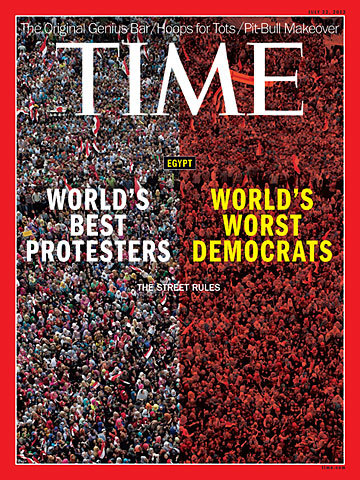
(2 of 6)
The street is where Brotherhood faithful set up camp after the coup, opposite a mosque in the Cairo district of Nasr City-- their own little Tahrir, complete with tents and vendors. They gathered broken pieces of curbing into piles for use as projectiles; then, after a couple of days, they crumbled the concrete into chalk to spell out an Arabic word that could be read from the air like an SOS: LEGITIMACY. After two days, the Morsi loyalists had blocked the two main roads between downtown and Cairo International Airport, outside which a pair of tanks were parked, one behind banners reading: EGYPT IS BIGGER THAN EVERYTHING. AND WE ARE ON THE SIDE OF EGYPT."
The street is also where several thousand Morsi supporters set off on the first Friday after the coup, marching peacefully up the west bank of the Nile until they reached the bridge leading toward the actual Tahrir Square, from which they were long ago ejected. The column turned instead toward the faceless edifice that houses state television. "We are just roaming around because they blocked the media from us where we were," says Essam Hassan, 51. "We're here to show the TV we are here, rather than sit and wait for the TV to come to us. We want to show the people on the ground."
They had this ground to themselves. The only police in sight stood smoking and watching from the door of their precinct, separated from the protest by a locked gate and an order to stand by. Which they did, even when a few dozen Brotherhood thugs approached Tahrir and were immediately confronted by anti-Morsi toughs intent on defending the square. The ensuing battle raged for more than an hour, directly beneath the cameras of the international press--a pyrotechnic display that included Roman candles fired as weapons, as well as real guns. Nearly 100 people were killed in the first week after Morsi's removal. The street, after all, is also where people go to fight.
"Now! Now! In the street, 30 million Egyptians are coming!" shouts Ibrahim Hassan, a willowy, intense Morsi supporter at a protest on Salah Salem Road, in front of the Republican Guard headquarters, where many believe the deposed President is being held. When I meet Hassan, four protesters have just been shot dead by the military. Other protesters proffer the evidence: a spent shell casing and a disk of skull bone, the blood already rubbed off by constant handling. Three days later, the scene would be one of even greater carnage: 51 protesters killed, along with three security officers. The military would claim thugs among the protesters fired the first shot; the Brotherhood would blame the soldiers and the chain of command, all the way up to the generals.
